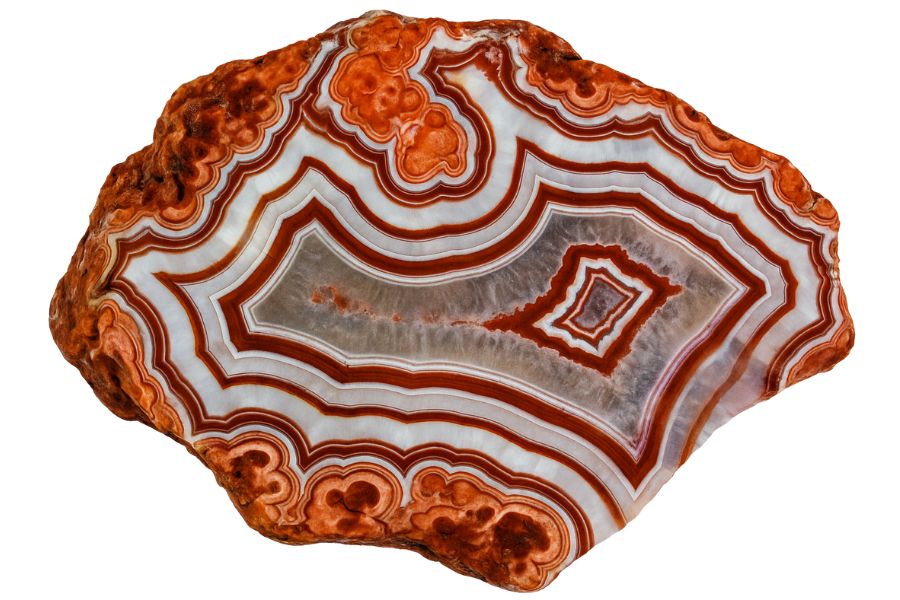You can find an amazing variety of agates in South Dakota hiding in its rivers, gravel beds, and open plains. You can find types like Fairburn, prairie, and moss agates scattered across different parts of the state if you know where to look.
Some are buried deep in the soil while others sit right on the surface waiting to catch your eye. Knowing how to recognize them can make your next trip out feel like uncovering buried treasure.
We will help you figure out where to begin your search and what to watch for along the way. With the right tips, you can bring home a collection that truly shows what South Dakota has to offer.
What is South Dakota Agate?
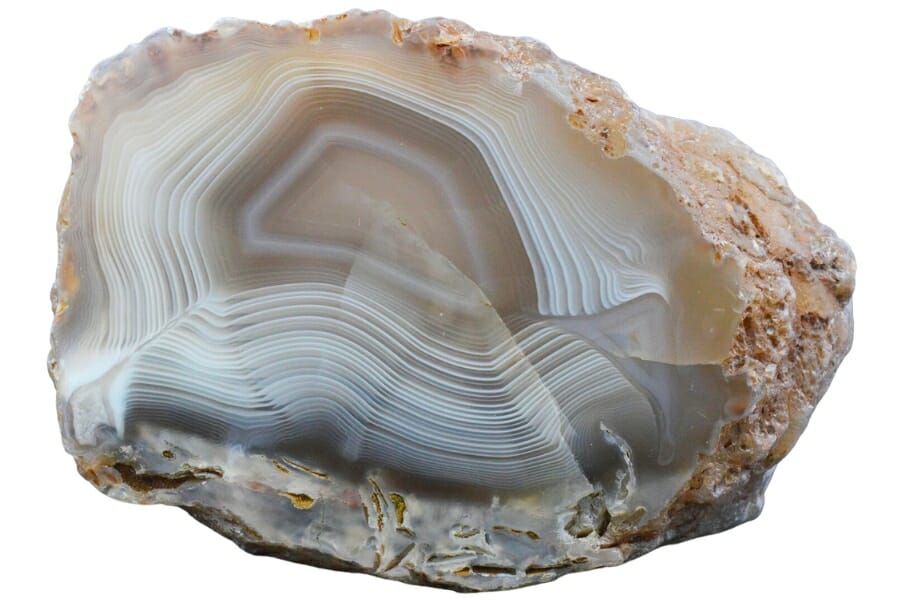
Imagine slicing open a rock and finding a masterpiece of art inside. That’s what agate is like!
It’s a type of quartz that forms when water, rich with silica, flows into pockets in rocks. Over a long time, this silica slowly turns into layers that stack up to create the cool patterns we see inside the stone.
Some agates have wavy lines, while others might have spots or blobs of color. Each one is unique, further pushing up agate’s value and worth.
Despite its beauty, agates can be found in many places around the world, usually in volcanic areas or ancient lava flows. The cool part? You can find them right here in South Dakota.
Now, before we share with you the best spots to find agates in South Dakota, let’s first get to know the different types of this gem and whether you can find them here:
Blue Lace Agate
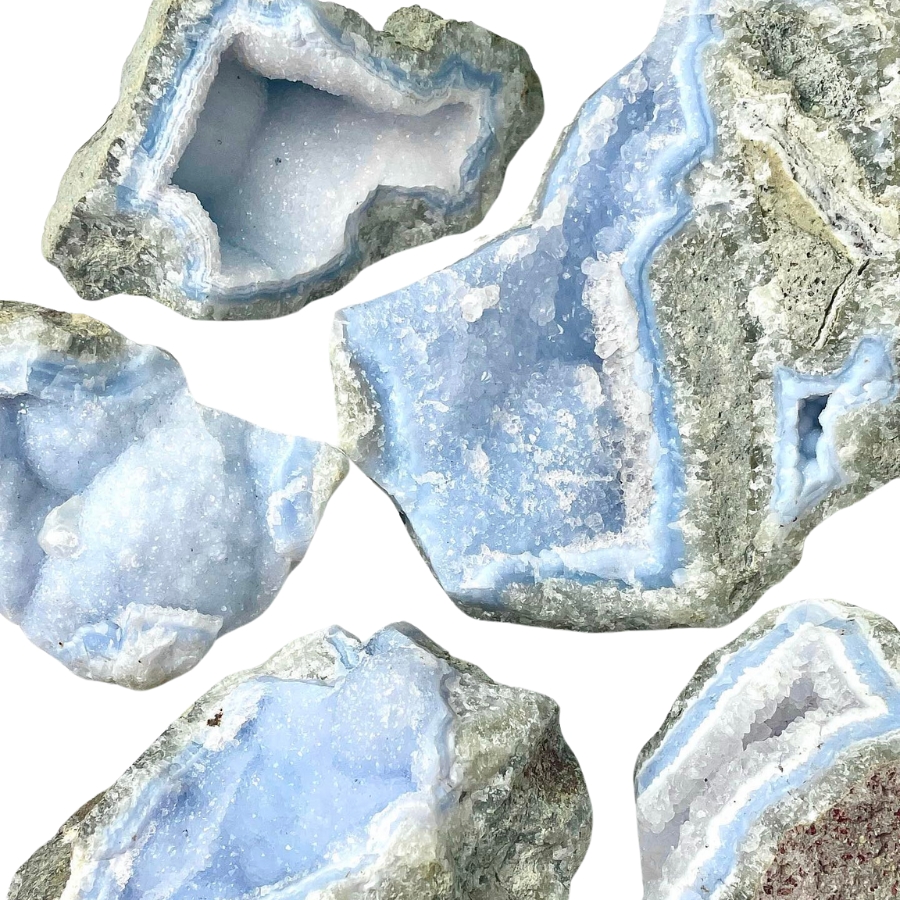
Blue lace agate is like the soft, sky-blue waves with lines that swirl and twist like delicate lace.
Its pattern comes from slow-forming layers of quartz, which create those beautiful, lace-like bands.
The bands of this agate type are often in shades of light blue, white, and sometimes a bit of grey. It’s different from other agates, which usually have more intense colors and stronger patterns.
The value of blue lace agate lies in its soft, tranquil look and the feeling of calm it brings. It’s often used in jewelry or as a decorative stone.
If you want REAL results finding incredible rocks and minerals you need one of these 👇👇👇
Finding the coolest rocks in isn’t luck, it's knowing what to look for. Thousands of your fellow rock hunters are already carrying Rock Chasing field guides. Maybe it's time you joined the community.
Lightweight, mud-proof, and packed with clear photos, it’s become the go-to tool for anyone interested discovering what’s hidden under our red dirt and what they've already found.
Join them, and make your next rockhounding trip actually pay off.
What makes it different:
- 📍 Find and identify 140 incredible crystals, rocks, gemstones, minerals, and geodes across the USA
- 🚙 Field-tested across America's rivers, ranchlands, mountains, and roadcuts
- 📘 Heavy duty laminated pages resist dust, sweat, and water
- 🧠 Zero fluff — just clear visuals and straight-to-the-point info
- ⭐ Rated 4.8★ by real collectors who actually use it in the field
Moss Agate
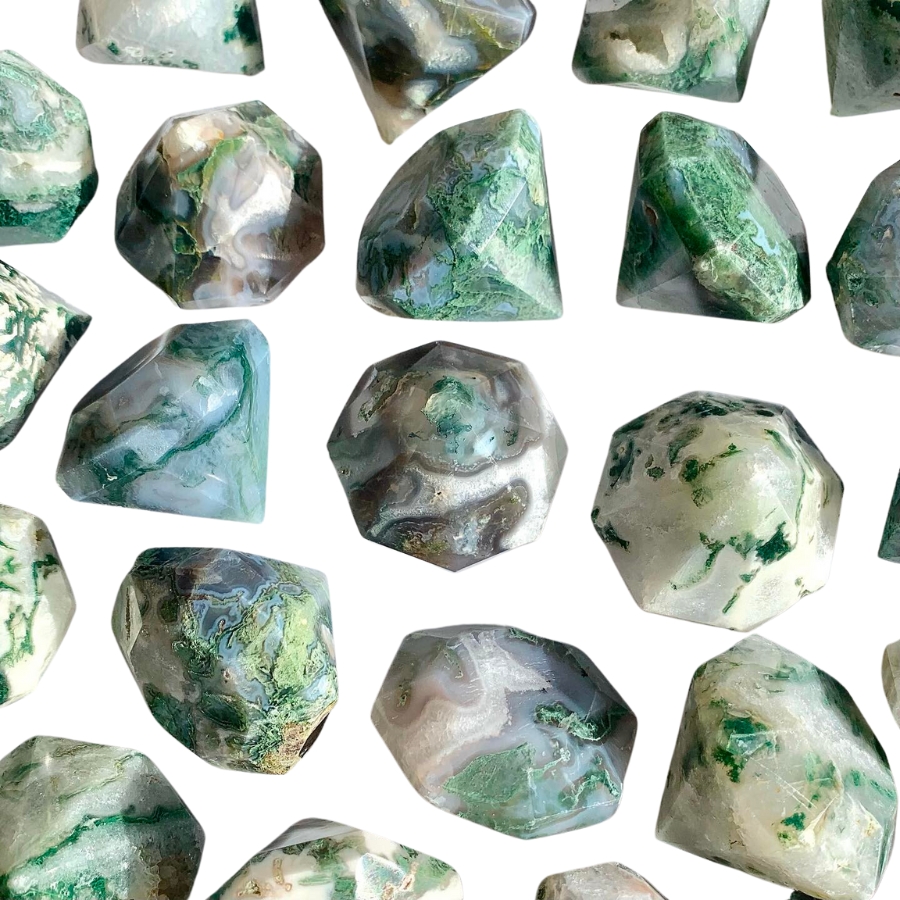
Instead of having the typical banding for which the different types of agates are known, moss agate has green inclusions that look like moss or trees.
These green patterns aren’t real plant material, though. They’re minerals like chlorite or iron oxide.
In some cultures, this type of agate is known as the “gardener’s stone” because of its green, plant-like appearance. It’s believed to help plants grow.
The price of moss agate can vary. It’s often quite affordable, but the more distinct and picturesque the green patterns, the more it might cost.
Fire Agate
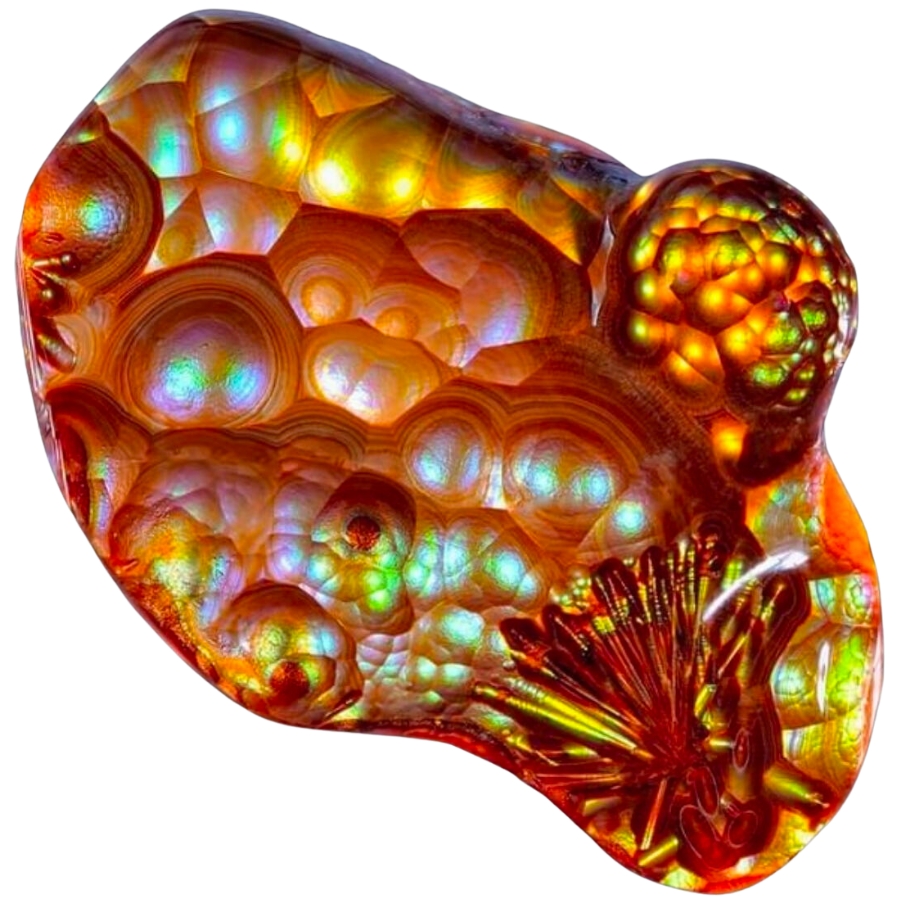
Fire agate is known for its incredible colors and the way it sparkles like fire. It’s got layers of silica and iron oxide that reflect light, creating a fiery effect.
When you look at fire agate, it’s like seeing flames trapped inside. Its colors can range from reds and oranges to greens and golds, all shimmering under the surface.
You might be wondering, “What is fire agate worth?” Well, its value comes from its rare beauty. The more color and sparkle, the more valuable the stone is.
Its fiery iridescence and lively play of color are used in jewelry pieces that are meant to stand out.
Dendritic Agate
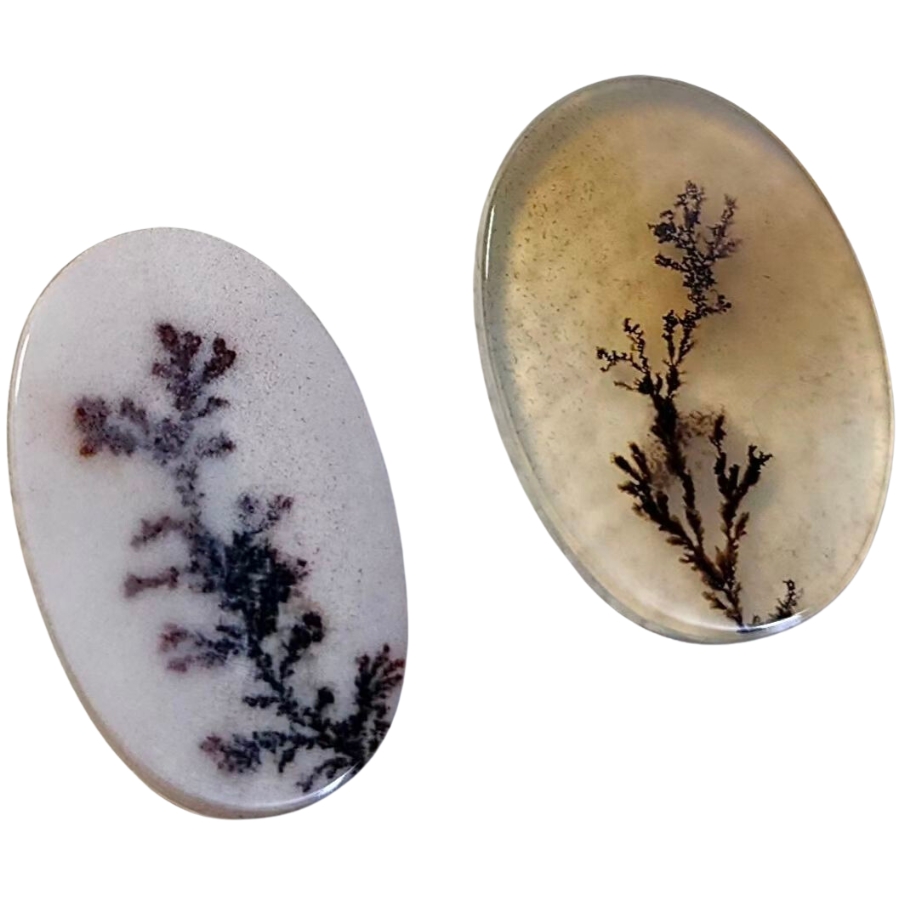
Dendritic agate is known for patterns that look like tiny trees or shrubs. Like moss agate, these patterns aren’t actual plants. They’re made of minerals, mostly manganese or iron oxides.
When you look at a dendritic agate, it’s like peering into a miniature forest or a frosty winter landscape.
The base of the stone is usually translucent to opaque, and the “dendrites”— those tree-like patterns— are often black or brown.
When it comes to how much dendritic agate is worth, it can vary. The more detailed and distinct the patterns are, the more it’s usually valued.
In some cultures, dendritic agate is believed to bring fullness and richness to life.
Crazy Lace Agate
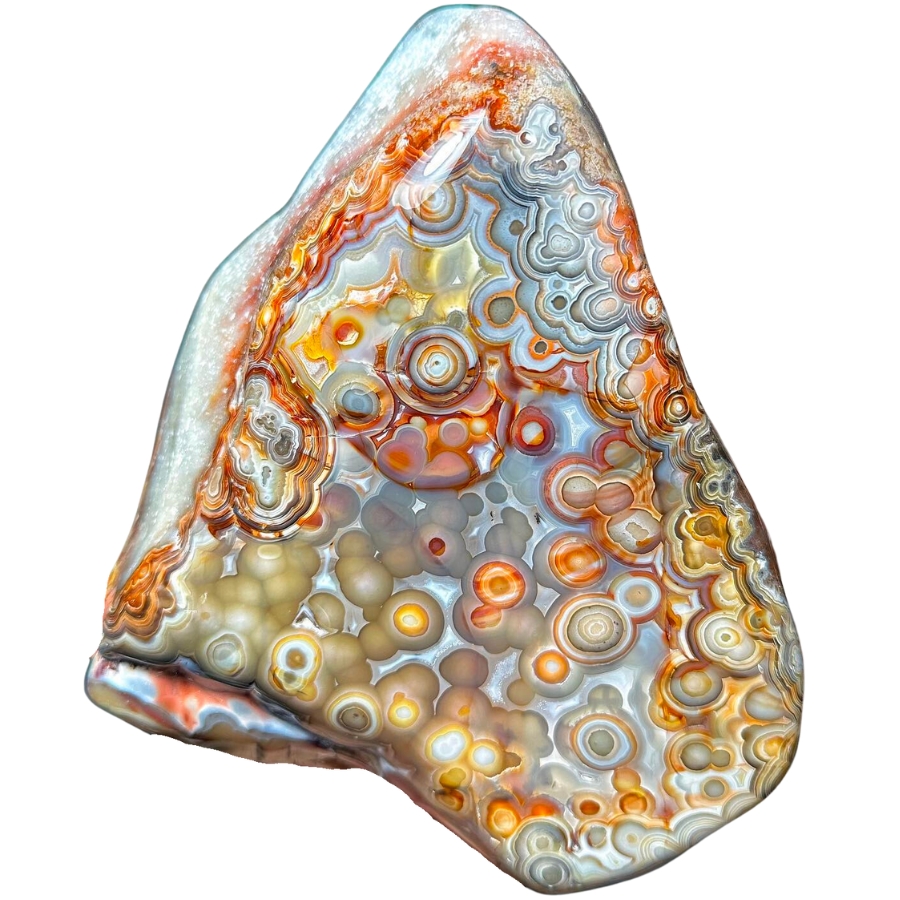
Crazy lace agate is like a party in a rock! It’s got swirls, circles, and all sorts of wild patterns dancing across it.
Its colors can be a mix of red, orange, yellow, and brown, and sometimes even a bit of gray or white.
What makes crazy lace agate stand out is its vibrant and complex patterns. No two pieces are the same. This distinctiveness is a big reason why it’s so valued.
Despite its wild and ‘crazy’ appearance, it’s sometimes called the “Laughter Stone” or “Happy Lace” because of the joy and positive vibes it’s believed to bring.
Laguna Agate
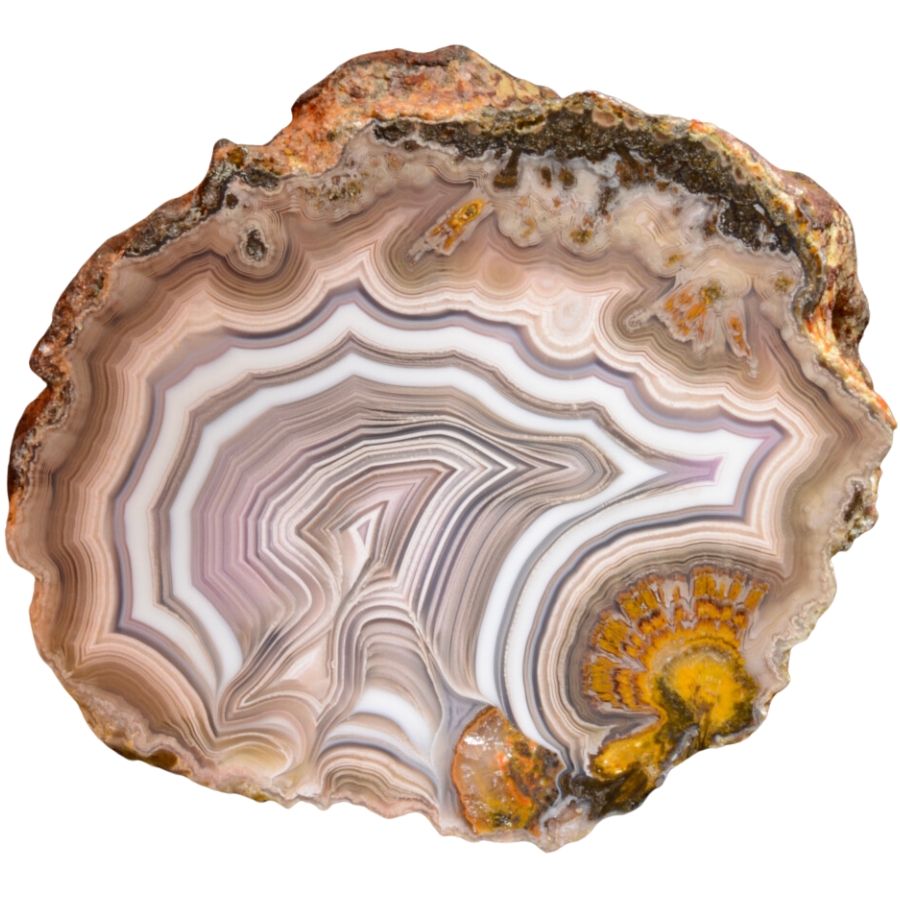
Laguna agate has incredibly sharp and fine banding. It has layers of red, orange, pink, yellow, and sometimes even purple and white all stacked in neat, tight bands.
These bands can form eye-catching patterns, like swirls, loops, and even landscapes.
The different colors of its bands come from various minerals present in the water at the time of its formation.
Laguna agate is considered one of the finest agates in the world due to its exceptional banding. This high regard among agate varieties makes it a prized possession for collectors.
Condor Agate
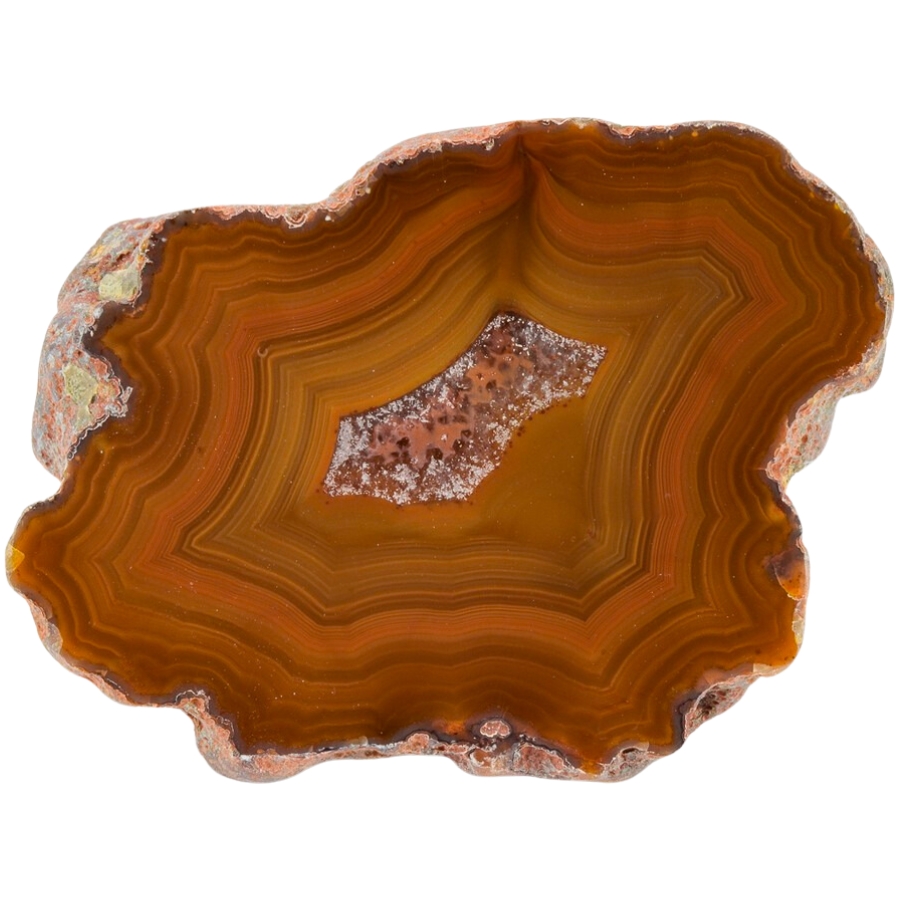
Condor agate is a real standout. It’s known for its bright, vivid colors and complex patterns.
It has reds, oranges, yellows, and sometimes even blues and greens all swirling together. These colors form in bands or in more random, artistic patterns.
The intensity and variety of its colors is what makes condor agate so special. It’s often used by artists and craftsmen who want to make a statement with their work.
Condor agate’s bold colors and patterns can turn a simple piece of jewelry or art into something really eye-catching.
Fortification Agate (Banded Agate)
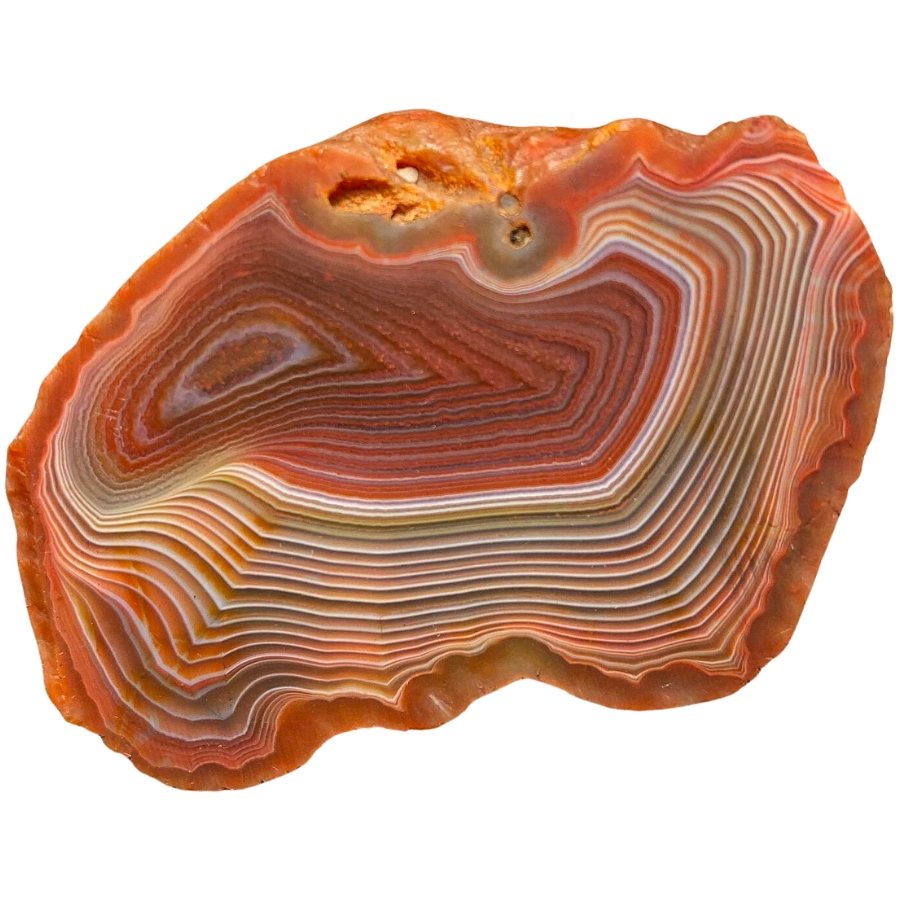
Fortification agate gets its name because the patterns inside it look like the aerial view of a fortified city.
Imagine seeing bands of color forming shapes that look like walls, with sharp angles and curves. They are usually in different colors, making each layer stand out.
If fortification agate is valuable, it’s because of its distinct patterns and colors. Its unique look makes it sought after for jewelry and as a collector’s item.
The clearer and more defined the patterns, the more valuable the stone can be. Some people also believe it can help with relaxation and calmness.
Iris Agate
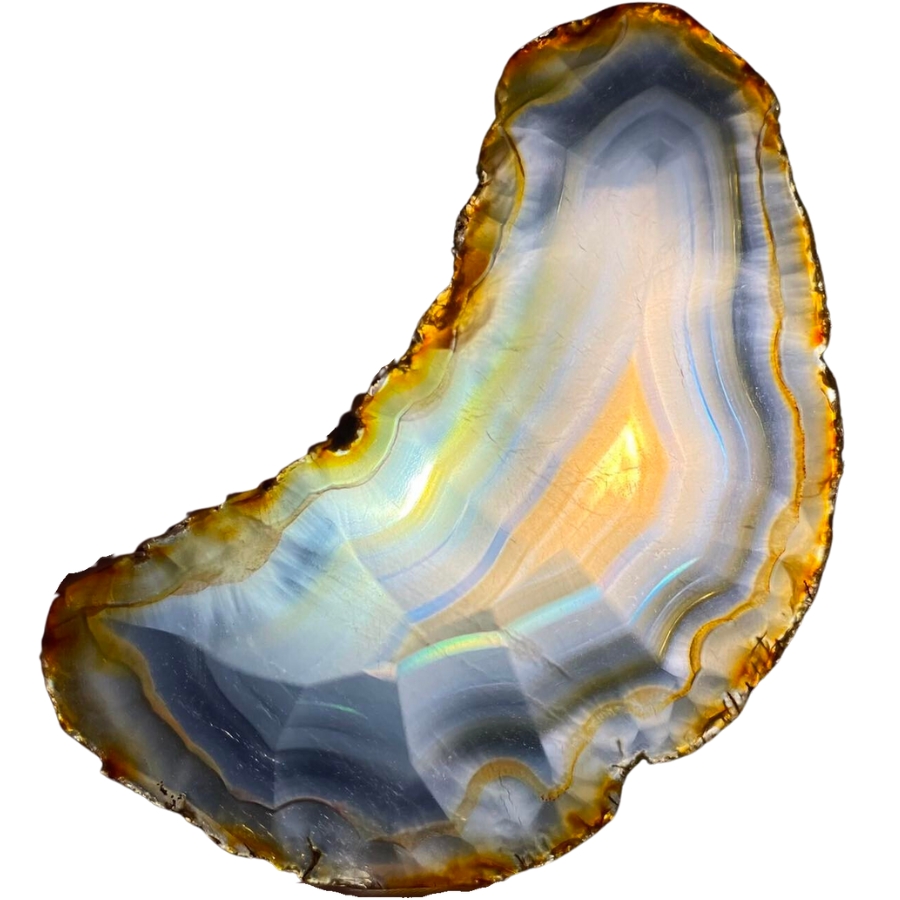
Iris agate looks like a regular agate at first, but when you hold it up to the light, something amazing happens. It shows all these rainbow colors, like light passing through a prism.
This is because it has very thin layers of silica, and when light hits these layers, it splits into all the colors of the rainbow.
The formation of iris agate is similar to other agates, but its layers are super thin, which is what creates the rainbow effect.
The value of iris agate comes from its unique ability to show these colors. In the past, people even used to think it had magical properties because of the way it showed colors. They saw it as a stone of good luck and wonder.
Plume Agate
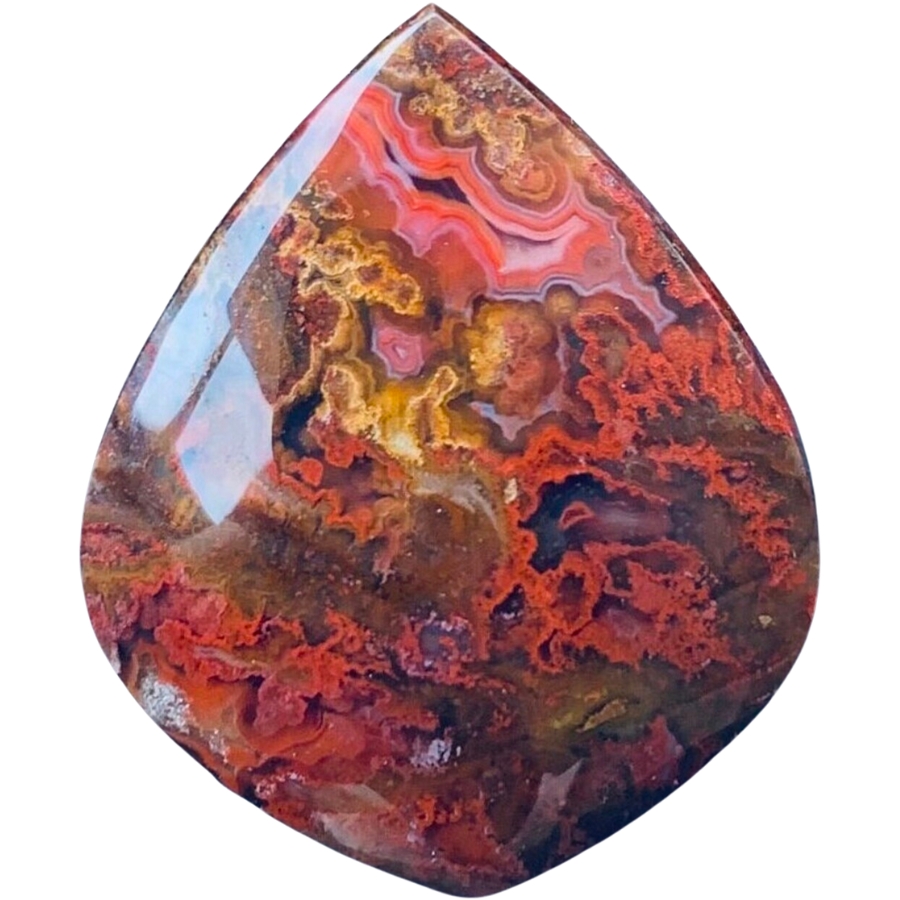
Plume agate gets its name from its patterns that look like soft, feathery plumes. These plumes can be in all sorts of colors: red, black, green, or yellow, set against a translucent or opaque background.
The way these plumes seem to float in the stone makes it look like a frozen underwater scene or like feathers caught in a breeze.
The plumes are made of minerals like manganese or iron oxide, which get trapped in the silica during the agate’s formation and create the feathery patterns.
The price of plume agate can vary depending on how clear and intricate the patterns are. The more detailed and colorful the plumes, the more the stone is usually worth.
Picture Agate (Scenic Agate)
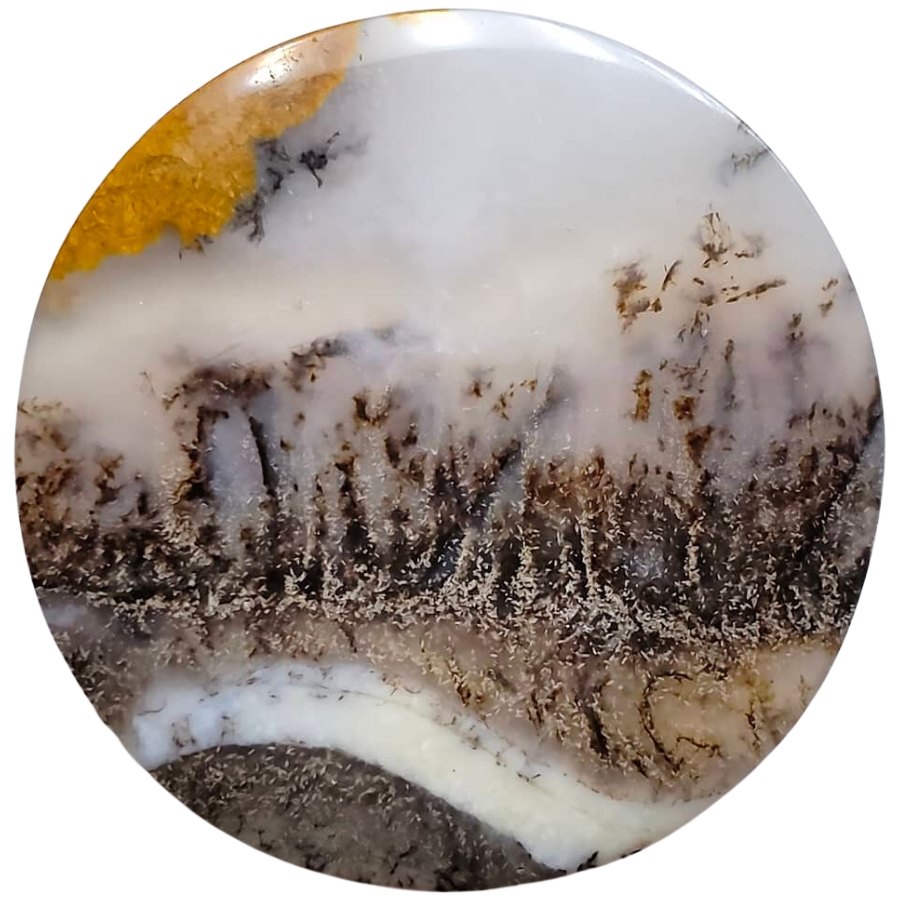
Picture agate is like a snapshot of nature captured in stone because it looks like it has pictures or scenes right inside it.
These “pictures” are actually natural patterns that resemble landscapes, mountains, trees, or even skies. They are usually in different shades of brown, white, and gray against a more translucent background.
The different patterns in picture agate or what’s also called scenic agate are made by various minerals in the water filled with silica that forms it.
If you’re thinking, “What is picture agate worth?“, its value comes from how distinct, clear, and detailed the natural “pictures” are.
Turritella Agate
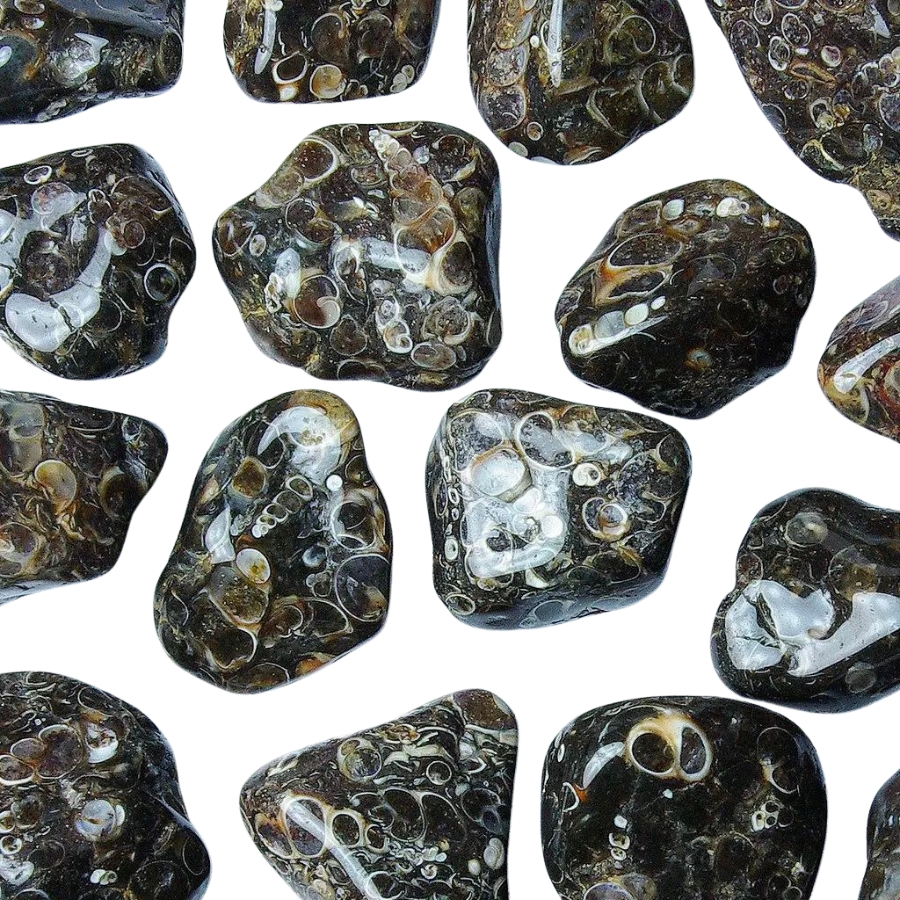
Turritella agate is not your typical agate because it’s full of fossilized snail shells! The shells belong to a creature called Turritella, a type of sea snail.
These shells are tightly packed and create a pattern that looks like a bunch of tiny, swirling towers. The background of the agate is usually a dark, earthy color, which makes the white or cream-colored snail shells really pop.
Over millions of years, these snail shells got buried in sediment and eventually became fossilized. As time went on, silica-rich water flowed through the sediment, turning it into the agate we see today.
The value of turritella agate comes from its unique blend of geology and history. More than a pretty stone, it’s a piece of ancient life preserved in rock.
Fairburn Agate
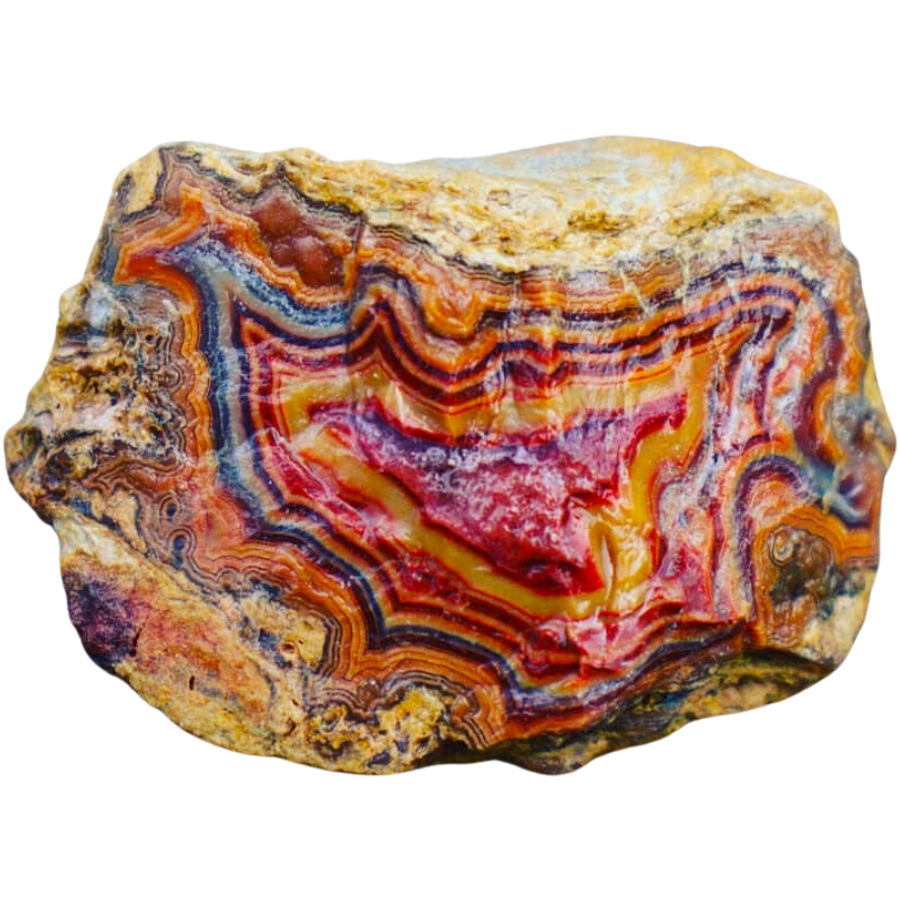
Known for its intricate patterns and bold colors, Fairburn agate is another fascinating type of agate. It usually has bands and swirls of different colors like red, yellow, orange, brown, and sometimes even pink or purple.
What’s special about these patterns is they often look like they’re in layers, creating a 3D effect. It’s like looking at a landscape made of stone.
It’s named after a place called Fairburn in South Dakota. This gives a clue about where it was first discovered.
People value Fairburn agate for the skill it takes to cut and polish it, which makes the patterns and colors really stand out.
Sagenite Agate
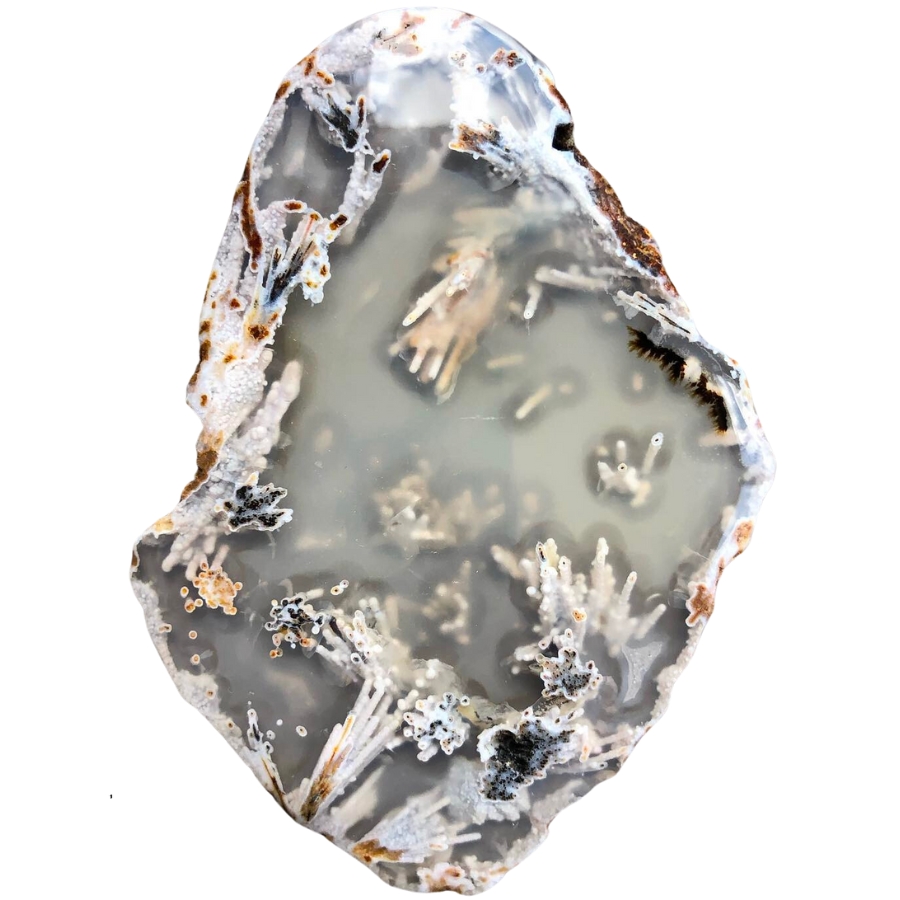
Sagenite agate has needle-like inclusions that look like tiny sprays of crystals inside it. They can be gold, silver, black, or even green, and they spread out in all directions, creating an amazing pattern.
The base of the agate is usually translucent, which lets you see these intricate needle patterns clearly.
These patterns are actually other minerals, like rutile or goethite, that get trapped inside the forming agate. These minerals grow in a crystal shape, looking like needles or hair.
Sagenite agate is often used in jewelry and other decorative items, with some people thinking that its needle patterns look like fireworks or starbursts.
Tree Agate
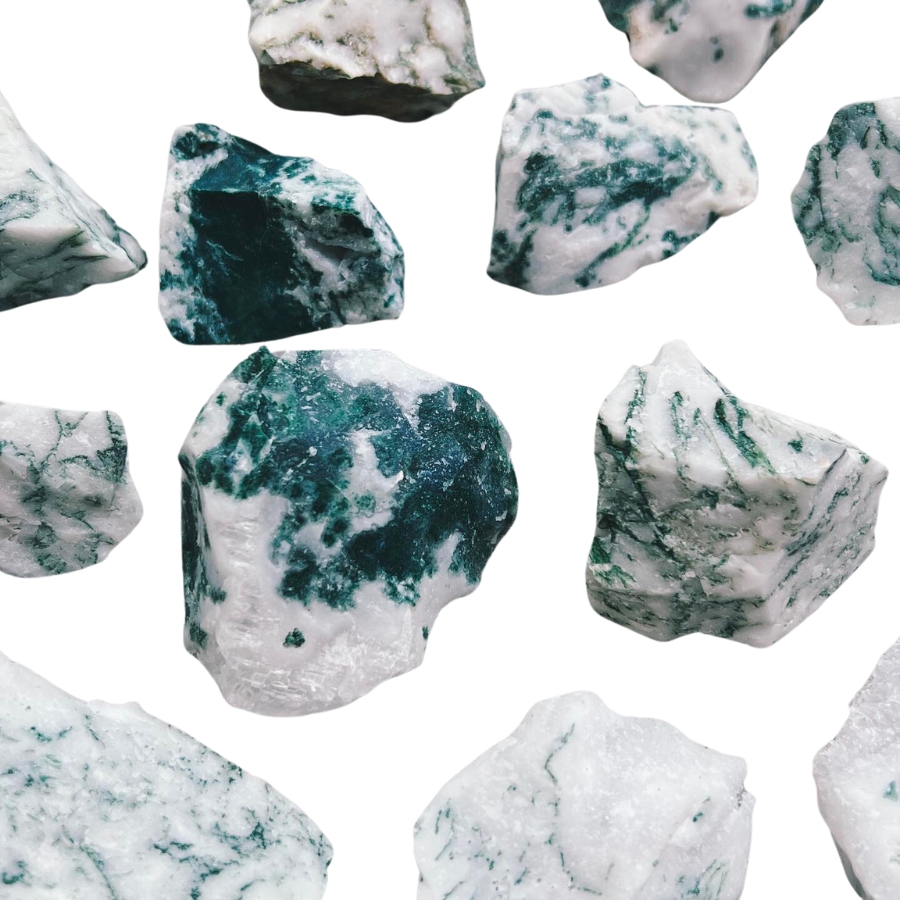
Tree agate, as its name suggests, looks like it’s got tiny trees or branches inside it. These tree-like patterns are usually green and spread out against a white or light gray background.
The green patterns aren’t actual trees, though. They’re made of minerals like chlorite or manganese.
Each piece of tree agate is different. You won’t find two that are exactly the same. It’s valued for its looks and it’s often used in jewelry and decorations.
The key factors in our recommendations are:
- The deep experience and understanding of our team about the area
- Recommendations from local groups and clubs
- How easy it is to get the a particular location
- Safety and potential hazards when collecting
- Weighing private and public locations
- The ability for both experienced and novice agate enthusiasts to find great samples
With these factors in mind we’ve been able to put together a fantastic list that just about anyone can use!
Kids. Beginners. Pros. Doesn’t matter. This book has become the go-to because it works for everyone.
Magy put it bluntly: “Identify rocks, crystals and minerals is so easy now!”
That’s not by accident, the photos are crisp, the callouts are simple, and the design is rugged enough to throw in a backpack without worrying. Whether it’s your first geode or your hundredth, this guide keeps the fun part simple: finding more treasures.
The Best Spots To Find Agates in South Dakota

South Dakota is endowed with many great gem mine sites. However, if you want to focus your search on agates, the best spots to find them are the following:
Always Confirm Access and Collection Rules!
Before heading out to any of the locations on our list you need to confirm access requirements and collection rules for both public and private locations directly with the location. We haven’t personally verified every location and the access requirements and collection rules often change without notice.
Many of the locations we mention will not allow collecting but are still great places for those who love to find beautiful rocks and minerals in the wild without keeping them. We also can’t guarantee you will find anything in these locations since they are constantly changing.
Always get updated information directly from the source ahead of time to ensure responsible rockhounding. If you want even more current options it’s always a good idea to contact local rock and mineral clubs and groups
Fairburn

Fairburn might be small in size, but it’s big on geological wonders. It’s surrounded by the vast landscapes of the Great Plains. The terrain here is a mix of rolling hills, grassy prairies, and unique rock formations.
When it comes to geology, Fairburn is a rockhound’s dream! It’s rich in minerals and gemstones, and it’s particularly known for a special type of stone: the Fairburn agate. They are famed for their stunning patterns and colors.
Getting to Fairburn is pretty straightforward. It’s accessible by road, and while it might be a bit off the beaten path, the journey is part of the adventure. Along the way, you’ll be treated to panoramic views of our diverse landscapes.
But before you head out here, it pays to review South Dakota’s updated collecting guidelines to make sure you’ll comply with them from the get-go.
Where we found agates in Fairburn
You can find agates about 10 miles northwest and south of the Game Farm Zoo, in badlands buttes to the end of the road, and south to the Cheyenne River in Fairburn.
Tepee Canyon

Nestled in the Black Hills region, Tepee Canyon is surrounded by a diverse range of landscapes that will leave any nature lover in awe. Here, you’ll see a blend of rocky outcrops, deep valleys, and lush forests.
Geologically speaking, this canyon is a wonderland. Among the geological treasures here are mesmerizing agates that are known for their vibrant colors and intricate patterns.
Reaching Tepee Canyon is an adventure in itself. Though it’s not as bustling as some of the major tourist spots, it’s accessible by road. However, the terrain can be rugged, so a good vehicle and some preparation might be necessary.
Where we found agates in the Tepee Canyon
To find agates, you can explore the diggings on the north side of the highway extending up to the Tepee Canyon.
Buffalo Gap

Buffalo Gap is a destination brimming with natural charm and geological wonders! It’s framed by vast prairies that stretch as far as the eye can see.
These open plains are occasionally interrupted by rugged badlands, presenting a mix of soft grassy terrains and dramatic rock formations.
Buffalo Gap sits in a region rich with geological treasures, including beautiful agates.
To travel here is like being on a journey of scenic beauty. Easily reachable by road, the town serves as a gateway to the Buffalo Gap National Grassland, a vast protected area showcasing the region’s natural splendors.
Where we found agates in Buffalo Gap
If you want to find agates in Buffalo Gap, you can search through the stream gravels, cut banks, breaks, and hillsides on the large area west to the county line.
Hell Canyon

Hell Canyon offers a mix of landscapes that would thrill any nature lover. Steep cliff walls, dense forests, and winding streams give the canyon its unique beauty. It has breathtaking tall rock formations and canyon floors with interesting trails and hidden nooks.
The rocks in this canyon are varied: some formed from powerful volcanic activities, while others from the slow shaping forces of erosion. Among these geological gems, agates have a starring role.
While the area is a bit secluded, Hell Canyon is accessible by road if you’re eyeing to go here. As you approach it, the landscape shifts from open plains to the rugged beauty of the Black Hills.
Where we found agates in Hell Canyon
You can find agates if you go north from the Jewel Cave National Monument to Hell Canyon.
Pleasant Valley Creek

Pleasant Valley Creek truly lives up to its name! It offers a tranquil escape with its gentle landscapes. The creek winds its way through the valley, nourishing the rich green meadows that surround it.
From a geological standpoint, Pleasant Valley Creek has some delightful surprises. Beneath the grassy surfaces and along the creek beds, rocks of various shapes and sizes hide, including agates.
The good news for you is that this spot is accessible by road. This makes it a great destination for families or solo adventurers who want a slice of South Dakota’s natural beauty without having to trek too far off the beaten path.
Where we found agates in the Pleasant Valley Creek
You can explore the area southwest of Pringle to find stunning agates in Pleasant Valley Creek.
Other Great Places To Find Agates in South Dakota

If you’ve already visited our top recommendations or are looking for other spots that you can explore here, below are many other agate-bearing sites in South Dakota:
Our recommendations by county
| County | Location |
| Custer | South along US-385 to Hot Springs |
| Custer | Beds surrounding town |
| Custer | Hills to the right of State Game Farm in Custer State Park |
| Custer | Wind Cave National Park |
| Fall River | Badland breaks in Ardmore |
| Fall River | Buttes in Oelrichs |
| Fall River | Stock dam and area breaks in Oelrichs |
| Fall River | Area on the north side of US-18 |
| Fall River | Huge alluvial gravel area in Oelrichs |
| Harding | Gravel bars of the Little Missouri River and all tributary creeks |
| Jackson | Kadoka area |
| Jackson | Buffalo Gap National Grassland in Philip Junction area |
| Meade | On top of the Fox Ridge area |
| Meade | Buttes on the north side of the road in Scenic |
| Minnehaha | Stream gravels, cut banks, gravel pits, and excavations in Sioux Falls |
| Minnehaha | Big Sioux River |
| Pennington | Hill City area mine dumps |
| Pennington | Hart Table Buttes |
| Shannon | Porcupine Creek to Sharps Corner |
| Shannon | Breaks along the road in Oglala to badlands in Smithwick |
| Shannon | Red Shirt area especially in breaks along the Cheyenne River |
| Washabaugh | Gravel beds, banks, and tributary draws of the White River |
| Washabaugh | General region to the north and east of Interior area |
Additional areas you can find agates
In case you’re having a difficult time locating agates, make sure you pay closer attention to the following specific areas where these rock often form and hide:
Streams and Creeks
Over time, as water flows in streams and creeks, it erodes the surrounding land and picks up different stones. The water’s motion often tumbles these rocks, smoothing and polishing them. When agates get caught up here, they’re transported and deposited in gravel beds or along banks, making them easier to spot.
The constant water flow also reveals new treasures, continually uncovering hidden agates and bringing them to the surface. This makes creeks and streams in South Dakota perfect hunting grounds for agates.
Rivers and Riverbanks
Rivers and their banks are nature’s grand showcases for many treasures, including agates. As rivers flow, they gather rocks from their sources, chiseling and carrying them downstream.
With their durable nature, agates resist this wear and tear, getting tumbled and smoothed in the process. This often brings out their vibrant patterns and colors. This makes riverbanks natural collection points for any rockhound.
Sediment Deposits
When water flows, it carries tiny bits of the land with it that settle and accumulate, forming sediment deposits. Agates, being resistant to weathering, often get nestled within these deposits.
That is why sediment deposits in South Dakota are prime search grounds for this gem. Every scoop of sediment that you’ll find can unveil beautiful South Dakota agates.
Common Agate-Hunting Questions

Before you start your journey here, we’ll answer some of the common questions when it comes to finding agates in South Dakota:
Is it illegal to collect agate in South Dakota?
Collecting agates for personal use is generally allowed on public lands in South Dakota, but there are some important restrictions to be aware of.
National Parks, for instance, prohibit the removal of any rocks or minerals. State Parks may also have their own set of rules. If you’re on private land, you’d need the landowner’s permission to collect anything, including agates.
It’s always a good idea to familiarize yourself with the specific rules of the area you’re in before collecting. You can also check out the official website of the South Dakota Bureau of Land Management (BLM) for more information.
The Best Places To Buy Agates In South Dakota

Aside from going out in the wild, you can also visit our trusted local rock and mineral shops that sell agates here in South Dakota. Below are some of our recommended ones.
- Dakota Stone Rock Shop – US-385, Hill City, SD 57745
- Dave’s Rock Shop – 1020 Mt Rushmore Rd, Custer, SD 57730
- Ken’s Minerals – 12372 US-16, Custer, SD 57730
- Rock Shed – 515 1st St, Keystone, SD 57751
- Things That Rock – 257 Main St, Hill City, SD 57745
If you have any recommendations for our list please leave a comment below!

